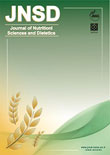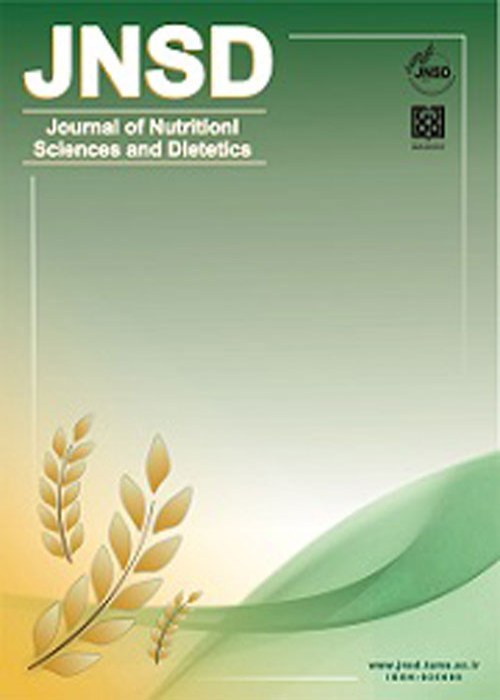فهرست مطالب

Journal of Nutritional Sciences and Dietetics
Volume:1 Issue: 3, Summer 2015
- تاریخ انتشار: 1394/09/30
- تعداد عناوین: 8
-
Pages 114-115
-
Pages 116-126BackgroundThe purpose of our study was to investigate the possible effect of BsmI vitamin D receptor (VDR’s) polymorphism on changes of the inflammatory and oxidative stress (OS) biomarkers in response to daily intake of vitamin D- fortified yogurt drink (doogh) in subjects with type 2 diabetes (T2D).MethodsIn a randomized controlled trial, 100 T2D subjects were allocated to two groups to receive either plain doogh (PD; n = 50, containing 170 mg calcium and no vitamin D/250 ml) or vitamin D3-fortified doogh (FD; n = 50, containing 170 mg calcium and 500 IU/250 ml) twice a day for 12 weeks. 25(OH)D, glycemic status, inflammatory as well as OS biomarkers were evaluated before and after the intervention. VDR-BsmI genotypes in an extended number of T2D subjects in the FD group (n = 140) were determined as BB, Bb, and bb.ResultsAfter 12 weeks, in FD compared to PD, serum 25(OH)D increased (+30.0 nmol/l vs. −4.8 nmol/l, p < 0.001). The 25(OH)D, parathyroid hormone, highly sensitive C-reactive protein (hs-CRP), malondialdehyde (MDA), and glutathione (GSH) in patients with the BB genotype were more responsive to vitamin D intake in which the maximum increment in 25(OH)D was in BB (31.8 nmol/l) compared with Bb (24.4 nmol/l) and bb (20.8 nmol/l) (p for trend < 0.001), and the difference in BB, compared to Bb and bb was significant [Bb (p = 0.024) and bb (p = 0.037)]. This difference was accompanied by a significant difference for other biomarkers including fasting serum glucose (p trend = 0.039), fat mass % (p trend < 0.001), interleukin 6 (p trend = 0.033), hs-CRP (p trend < 0.001), and MDA (p trend = 0.028) which significantly all decreased in BB genotype except for GSH which significantly increased (p trend = 0.035).ConclusionDaily intake of vitamin D-FD for 12 weeks improved the inflammatory and OS biomarkers in T2D subjects, and the improvement was more pronounced in the carriers of BB genotype of VDR-Bsm.Keywords: Vitamin D_Oxidative stress_Inflammation_Type 2 diabetes_BsmI polymorphism_vitamin D receptor gene
-
Pages 127-133BackgroundTo compare the oxidative stress (OS) factors in obese and non- obese subjects with Type 2 diabetes (T2D) and to evaluate the interaction between the apolipoprotein A-II (Apo A-II) - 265T > C polymorphism and body mass index (BMI) on OS factors.MethodsIn this comparative cross-sectional study, 21 diabetes centers in Tehran, Iran were studied. 180 patients with T2D were divided into two groups of 90 obese (BMI ≥ 30) and 90 non-obese (BMI < 30) with equal numbers of each genotypes of Apo A-II (TT = 30, CC = 30 and TC = 30). Superoxide dismutase (SOD) activity, total antioxidant capacity (TAC) and 8-isoprostane F2α concentration were compared between two groups obese and non-obese and between subjects with and without central obesity. Then, the interaction between the Apo A-II polymorphism and BMI on OS factors were analyzed by general linear model.ResultsAfter adjusting for confounding factors, it was observed that the mean of SOD activity and TAC were lower in the obese group than in the non-obese group (p < 0.050). The mean concentration of 8-isoprostane F2α was not statistically different between the two groups. Adjusting for BMI showed that the differences in the mean OS factors were not statistically significant between men and women with and without central obesity. It was also observed that the interaction between the Apo A-II polymorphism and BMI on OS factors were not significant.ConclusionOS level was the higher in obese subjects with T2D than non-obese one. The interaction between BMI and Apo A-II polymorphism had not a significant effect on OS factors.Keywords: Obesity_Apolipoprotein A_II_Type 2 diabetes_Oxidative stress
-
Pages 134-140BackgroundObesity is recognized as a major public-health problem, which has reached epidemic proportions, in both developed and developing countries. The purpose of this survey is to study effects of gastric bypass surgery at micronutrients and macronutrients intake on patients with morbid obesity.MethodsThis quasi-experimental study was conducted on 21 patients. Anthropometry information (weight, height, age, and gender) and three 24-hour recall questionnaires were completed for each participant: Before surgery and 3 months after surgery.ResultsThe total intake of macronutrients including carbohydrate, protein and fat decreased between baseline at 3 months post-surgery that was statistically significant for all of the macro-nutrients (p < 0.001). There was a reduction of energy intake from carbohydrate (54.81% ± 20.03% to 44.34% ± 14.59%, p = 0.059) and the energy intake from protein (18.57% ± 5.73% to 26.24% ± 9.83%, p = 0.001) and fat (31.06%± 8.64% to 35.18% ± 25.41%, p = 0.460) along the prospective follow-up period compared to previous values. The mean intake of all micronutrients had decreased during follow-up that was statistically significant for B group vitamins (B1, B2, B3, and B6), float, iron, zinc and copper (p < 0.017 for vitamin B2, p < 0.001 for others).ConclusionOur data demonstrate that low dietary intake of energy, micro- and macro-nutrients absolute values and relative to the recommended dietary allowances and estimated average requirements, are highly prevalent after Roux- en-Y gastric bypass (RYGB) surgery. Therefore dietary counseling, clinical assessments, and the recommendation of supplements if needed in pre- and post- operatively, might be considered for health promotion after RYGB surgeries.Keywords: Gastric bypass surgery, Food intake, Morbid obesity
-
Pages 141-148BackgroundFood insecurity has an impact on social-emotional development, school attendance, and academic performance. It is critical to understand the impact of food insecurity on academic standing and its relationship with socio- economic status on adolescent health outcomes. The aim of this study was to investigate the association between food insecurity and socio-economic status, and academic standing among high-school girls in Noshahr, Iran.MethodsThis cross-sectional study was conducted on 525 students. All girls were from private and public high schools in Noshahr from March 2014 to June 2014. Food security was assessed using the United States Department of Agriculture 18-item standard questionnaire. A structured questionnaire was used with a wide range of questions for socioeconomic status (SES) and academic performance.ResultsFood insecurity prevalence was 41%, and 25% of marginal food security.Significant difference was found in grade point average (GPA) between food secure and insecure students p < 0.001. The results of logistic regressions showed food secure students are less likely choose technical fields [odds ratio (OR) = 4.902; 95% confidence interval (CI): 1.313-18.304] and more likely have higher GPA, (OR = 0.555; 95% CI: 0.391-0.786), father with secure and higher paid jobs (OR = 5.841; 95% CI: 2.640-12.923), and healthy family members (OR = 1.852; 95% CI: 1.190-2.883).ConclusionFood insecurity was a common health problem among students, and SES of parents had main effects on student achievement. The negative impact of food insecurity on student academic performance needs urgent attention. Nutrition education is necessary to improve the quality of lifestyle and empower students to build a successful learning strategy.Keywords: Food security, Socio, economic status, Academic performance, Adolescent, Food insecurity
-
Pages 149-156BackgroundNutrition status is an important constituent of health in an elderly and evaluation of these groups are necessary for development of treatment protocols. The study aimed to estimate the prevalence of malnutrition with mini nutritional assessment (MNA) tool in the elderly living in nursing homes. In addition, the association of MNA results and functional status was investigated.Methods245 of elderly residents in nursing homes in Tehran (90 men and 155 women) were studied. Data were collected using the MNA, anthropometric measurement, and functional evaluations by Katz Index.Results35.1% showed normal status while 55.9% have been classified at risk malnutrition and 9% suffered from severe malnutrition based on MNA scores. Katz score showed that 20.4% older people absolutely depended on others for all of activities for daily living. There was significant difference in score of Katz index according to gender (p < 0.050). A positive correlation was found between MNA scale and Katz index (r = 0.251, n = 245, and p = 0.001). Analysis of logistic regression controlled for age and gender showed in those at risk of malnutrition a higher MNA score significantly lowered the risk of being dependent based on Katz index (odds ratio: 2.14, confidence interval: 1.15-3.98 and p = 0.016), however this relationship was not observed elderly subjects who were malnourished [2.53 (0.92-6.95) and p = 0.070).ConclusionThe study demonstrates high provenance of risk malnutrition, as well as the close association between functional status and nutritional status in the elderly subjects. Considering the results, a larger study concerning nutritional status and functionality in the elderly living in nursing homes is warranted.Keywords: Elderly, Malnutrition, Mini nutritional assessment, Katz index
-
Pages 157-164BackgroundNutritional care is of special importance in the control of the rate of mortality among intensive care unit (ICU) patients. Therefore, anthropometric and biochemical assessment are important among ICU patients. We intend to report the anthropometric and biochemical indices, as well as the energy intake among ICU patients in Isfahan, Iran.MethodsThis descriptive study was carried out in Isfahan, Iran on 100 patients admitted to the ICU. Height, weight, mid arm circumference, and energy requirements were measured in this population. Some biochemical factors, such as albumin, creatinine, lymphocytes count, sodium, potassium, phosphorus, and magnesium, were measured twice within a week interval by biochemical tests. Any kind of disease, having infection or bedsore, taking oral ventilation and the kind of nutrition has been assessed in each patient.ResultsSerum albumin level was less than normal range in 67% of patients based on measurements in the first day of staying in ICU. The prevalence increased to 77% in the seventh day of hospitalization in ICU (p = 0.040). There was a significant reduction in the mean of mid arm circumference after 1 week staying in ICU (p = 0.001). There were significant differences between energy intake and the amount of energy requirements in these patients (p = 0.035).ConclusionICU patients have been exposed to lower energy intake compared to their requirements and their mid arm circumference reduced significantly after 1 week staying in hospital. Therefore, they require special nutritional care.Keywords: Malnutrition, Nutritional assessment, Anthropometric indices, Intensive care unit patients
-
Pages 165-170BackgroundScientific literature has shown evidence that omega-3 polyunsaturated fatty acids (PUFA) have anti-androgenic action, and for this reason could be useful as an adjuvant in hyperandrogenism conditions including polycystic ovarian syndrome (PCOS). However, the possible effect of eicosapentaenoic acid (EPA) and docosahexaenoic acid (DHA) supplementation on testosterone concentration still remains undetermined. Therefore, we performed a meta-analysis to investigate effects of EPA/DHA supplements on testosterone hormone in PCOS women.MethodsRandomized controlled trials (RCTs) published until end May 2015 were searched through a comprehensive search of the PubMed and Scopus electronic databases. Included RCTs evaluated omega-3 fatty acids supplements compared with control in patients with PCOS and reported circulatory androgens. The meta-analysis quality assessment was conducted by the Jadad scoring criteria.ResultsFour RCTs were analyzed in this meta-analysis. The dose range for EPA and DHA was 0.9-3.6. Follow-up ranged from 6 to 8 weeks. Meta-analysis on testosterone levels revealed a significant lowering effect (weighted mean difference - 0.264; 95% confidence interval = −0.39, 0.14; p < 0.001) of omega-3 fatty acids for PCOS subjects.ConclusionThe results of our study revealed benefits on total testosterone with the use of omega-3 PUFA supplements on PCOS patients. Further, high-quality RCTs are required to definitively draw a causal interpretation of our finding.Keywords: Polycystic ovarian syndrome, Fatty acids, Meta, analysis, Testosterone


